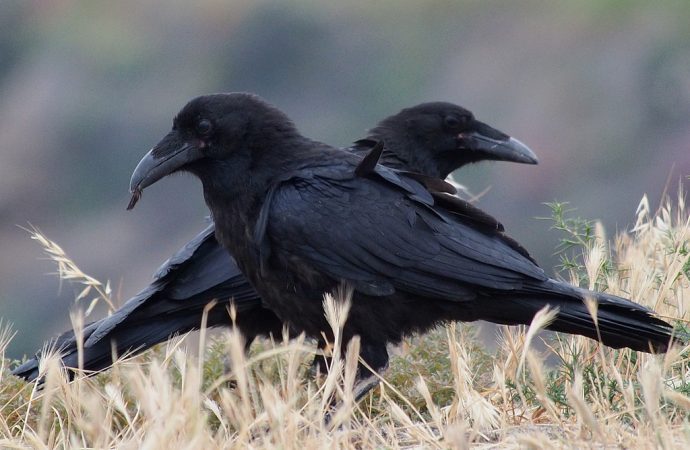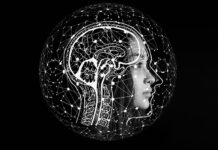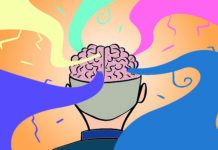Ever wondered what it might be like to see things as a cat, or dog, or as your favourite animal? Turns out that ravens can do the same – though at a much simpler level.
This is called “Theory of Mind (ToM),” and is a trait that has been proposed to exist in certain great ape species as well as several monkeys.
The study was led by Dr. Thomas Bugnyar of the University of Vienna, and it involved testing a number of ravens in a laboratory setting – using two rooms separated by a small peep-hole. The test-subject would be placed in one of the rooms, alongside a stash of food.
Ravens will guard their food stash whenever they see other ravens nearby. However, they WON’T engage in that behaviour if they can only hear raven-calls. In the room with its stash, the raven showed no such behaviour so long as the peep-hole was kept shut as raven-calls were coming from the other room next door.
Once the peep-hole was opened, though, and the test-raven could glance into that other room, then the guarding actions began.
What makes this an example of ToM, and not simply defensive behaviour as has been proposed, among other things such as familial behaviour – especially with primates – is that the sounds were mere recordings on tape. The test-raven had no visual confirmation that there was indeed another raven in that other room hungry for its food, yet it would still act as if there was; perhaps thinking that the would-be raven was hiding just out of its range of vision through that tiny peep-hole.
If this study is as unique as it is claimed to be, then it certainly stands as another, little piece of evidence that we humans are not as uniquely endowed mentally as we’ve always thought. While ravens’ ToM is currently restricted to other corvids, the fact that ravens are able to conceive that another bird could be watching them is in itself an important discovery.
The next step from here is likely to re-evaluate this cognitive ability in primates, and also to see if other intelligent animals such as dolphins and octopi have this trait. Finally, since we presently do not know when this trait first expresses in our own species, to actually conduct this sort of test on human infants should also be worth-while.
Another avenue to take here would be to try to figure out what kind of evolutionary steps are usually required in order for the first inklings of ToM appear in a species, although certainly there are a number of hypotheses out there proposed already – for example, in Bugnyar’s study in particular, it is offered that being able to predict which food sources may be competed over in a given season or year is an important, likely primary evolutionary advantage that can certainly aid in the particular raven’s ability to ensure it can always have access to sufficient sustenance.
Source
Bugnyar, T., Reber, S., & Buckner, C. (2016). Ravens attribute visual access to unseen competitors Nature Communications, 7 DOI: 10.1038/ncomms10506
Ravens can theorize about minds
Theory of mind
Image Credit: Ingrid Taylar / Flickr

Ravens Can See Themselves As Someone Else
Comments are closed.





When we as humans look into a mirror we recognize ourselves. Well… not at first, most babies go through the stage of being scared of what they see in the mirror until they reach the age where they recognize themselves. This is an important growth milestone when this happens. As more animal research is done (sadly) we see that there are animals who pose this same feature as humans do.
The ravens, great apes, as well as a lot of different species of monkeys’ have developed the Theory of Mind. There could have been many different reasons why they have developed this “higher brain-function”. I have never studies ravens but I do believe that they are scavenging birds so the ToM helps as they protect their food. Also they have had to adapt because of heredity, because of past generations of ravens.
Kalat, J. W. (2014). Biological psychology. Boston, MA: Cengage.
The fact that Theory of Mind exists in great apes, as well as ravens is quite interesting, because it is something that most prominently exists in humans. Humans use this every single day without even thinking about what it means, or the complexity of the cognitive processes involved. Human brains are bigger and better than other species, which allows us to create solutions to problems that we’re unfamiliar with. Generally, for a species to develop a bigger brain, sacrifices must be made in other areas of the body, such as organ function or physical endurance. Research suggests that humans were able to develop their big brains due to learning how to cook food early on in their history, making it easier to digest, thus conserving energy (Kala 2014). However, primates and ravens share Theory of Mind, which means that these animals might be conserving energy and nutrition for brain function and development.
The raven might be using Theory of Mind, but it is probably not doing so out of altruism. Altruistic behavior would mean that the raven uses Theory of Mind selflessly, which is not the case. For example, the raven in the study would alter its behavior if there was a sound recording played of another raven. This means that the raven could be using Theory of Mind to better understand its competitors in its environment, or even its prey. It could also use Theory of Mind to better interact with other ravens, and signal them to feed together, which removes the raven from danger during feeding (Kalat, 2014).
Reference
Kalat, J. W. (2014). Biological psychology. Boston, MA: Cengage.